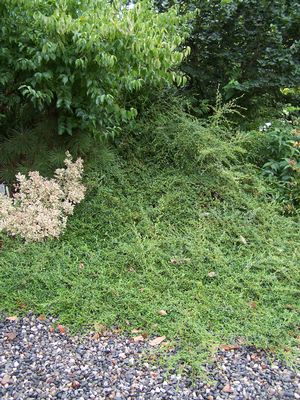View All Plants :: View All BROADLEAF EVERGREEN SHRUBS :: View All DECIDUOUS SHRUBS
Cotoneaster salicifolius 'Repens (small leaf form)'
Willowleaf Cotoneaster
Plant Type:
BROADLEAF EVERGREEN SHRUBSCotoneaster salicifolius 'Repens' (small leaf form) - This more refined prostrate form of Willowleaf Cotoneaster. The smaller leaves are glossy dark green growing no more than 7/8ths of an inch long. Countless small pink buds blossom light pink and quickly age white. The teardrop-shaped pomes that follow turn red and stud the green leaves which turn a beguiling burgundy in fall and winter. This plant is evergreen for us and it is especially beautiful in the winter. Cotoneaster salicifolius 'Repens' (small leaf form) originally came to us from Environmentals Nursery. Full sun in fertile draining soil. Established potted Cotoneaster, cutting grown.
Characteristics and Attributes for Cotoneaster salicifolius 'Repens (small leaf form)'
Season of Interest (Flowering)
- Spring
Season of Interest (Foliage)
- Four Seasons
Interesting Bark
- Mat Forming / Creeping
Autumn Interest
- Fruit / Berries / Seed Heads
- Autumn Leaf Color
Nature Attraction
- Songbirds
- Honey Bees & Native Bees
Light
- Full Sun
- Mostly Sunny
Attributes
- Edging
- Evergreen
- Ground Cover
- Bank
Growth Rate in the Garden
- Moderately Fast
Soil
- Fertile
- Draining
Origins
- Garden Origin
Propagated By
- Cutting Grown
Genus Overview: Cotoneaster
Cotoneaster (pronounced Cuh-toe-nee-AZ-tuhr) as a genus has been ignored in recent years. I have found it odd that plants go in and out of fashion. From my humble standpoint a good plant is a good plant in any generation. Some Cotoneasters are virtually evergreen, others deciduous. Most have terrific fall foliage color. All have pretty flowers usually followed by a beautiful fruit set – many hold fruit well into winter. They are good wildlife plants for many species of birds relish the fruits. They prefer fertile soil but demonstrate moderate drought tolerance once settled in. However, if you cheat these members of the Rosaceae too much they will languish. All of our offerings are cutting grown.


